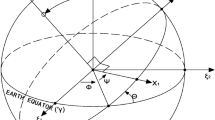Abstract
This study briefly describes the targets and problems of the future Japanese project In situ Lunar Orientation Measurement (ILOM), which is planned for the year 2017. One of the important parts of the project is to place a small optical telescope on the Lunar surface with the purpose to detect the Lunar physical libration with unprecedented accuracy 0.001 arcsec. At the present stage of research the computer simulation of future observations is going on, aiming to determine the moments of transition of a star through the first meridian and the polar distance of the star. Rotation of the Moon is being calculated under the analytical theory developed in the frame of a theme of the grant. A list of stars brighter than 12 m, whose coordinates are close to the Lunar precession pole motion, was constructed on the basis of several star catalogues. On average, for each moment of observation in the field of view of the telescope (1°) there are approximately 20–25 stars. Analyses of simulated stellar tracks observable from the Lunar surface (in a polar zone) reveal the significant difference from daily parallels of stars in comparison with the Earth. During one Lunar “day” equal 237 terrestrial days, a star moves on a spiral. However, depending on a longitude of a star, these spirals can be untwisted or twisted. In the latter case a star can describe a loop in the sky of the Moon during the period of supervision. Such an unusual astrometric phenomenon combined with the slow rotation of the Moon is compared with the Earth and the fast precession motion of the Lunar pole (in comparison with the precession motion of a terrestrial pole).
Similar content being viewed by others
References
Hanada H, Sasaki S, Kikuchi F, et al. Observation of Lunar Rotation by Future Landing Missions. Vienna: Copernicus, 2009. 11
Petrova N, Gusev A, Hanada H, et al. Interpretation of the Lunar Physical Libration for Future Observations from the Lunar Surface. Münster: Copernicus, 2008. 3
Petrova N, Gusev A, Kawano N, et al. Free librations of the two-layer Moon and the possibilities of their detection. Adv Space Res, 2008, 42: 1398–1404
Petrova N. Analytical extension of Lunar libration tables. Earth Moon Planets, 1996, 73(1): 71–99
Petrova N, Barkin Y, Gusev A, et al. Physical libration of the multi-layered Moon: Theoretical and applied aspects, modelling of internal structure. In: Abstract of workshop “The Moon in SELENE mission and ILOM project”, Mitaka (Tokyo), March 15–18. Astrometry News (NAOJ). Tokyo: NAOJ, 2008. 3: 2
Konopliv A S, Binder A B, Hood L L, et al. Improved gravity field of the Moon from Lunar prospector. Science, 1998, 281(5382): 1476–1480
Author information
Authors and Affiliations
Corresponding author
Rights and permissions
About this article
Cite this article
Petrova, N., Gusev, A., Ping, J. et al. Lunar project ILOM: application of the analytical theory of Lunar physical libration for the simulation of star observations. Sci. China Phys. Mech. Astron. 55, 888–891 (2012). https://doi.org/10.1007/s11433-012-4698-5
Received:
Accepted:
Published:
Issue Date:
DOI: https://doi.org/10.1007/s11433-012-4698-5




